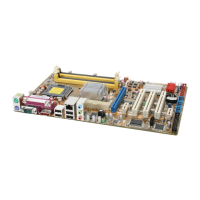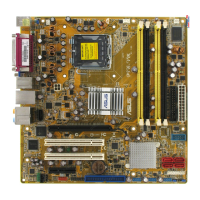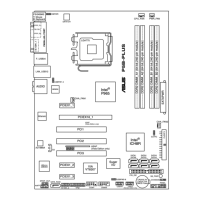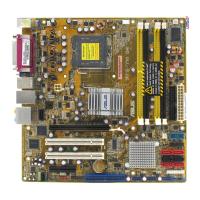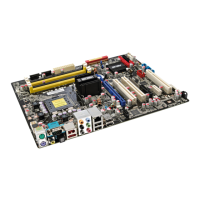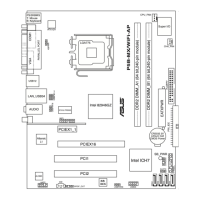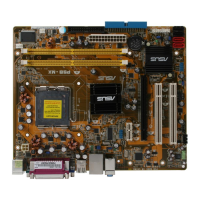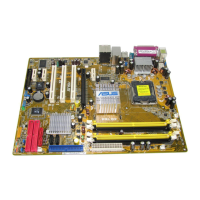Do you have a question about the Asus P5B Premium Series and is the answer not in the manual?
Precautions to prevent electrical shock hazard and ensure safe handling of components.
Guidelines for safe installation and operation to prevent damage and ensure system stability.
Details the CPU socket and compatible Intel processor families supported by the motherboard.
Information about the Intel P965 Express Chipset, its features, and support for various technologies.
Specifications for DDR2 memory support, including type, speed, capacity, and dual-channel architecture.
Details the types and number of expansion slots available, including PCI-E and PCI slots.
Information on SATA and PATA controllers, including number of ports and RAID support.
Specifications for the Dual Gigabit LAN controllers and AI NET2 feature.
Details the ADI AD1988B 8-channel High Definition Audio CODEC and S/PDIF output.
Information on the TI 1394a controller and the number of IEEE 1394a ports.
Specifications for the USB 2.0 ports, including quantity and location.
Details all internal connectors on the motherboard for system components and peripherals.
Outlines intelligent overclocking tools like AI NOS, AI Overclocking, and Precision Tweaker for performance tuning.
Lists the BIOS features, including Flash ROM size, BIOS type, and supported technologies.
Lists all connectors and ports available on the motherboard's rear panel for external connectivity.
This chapter describes the motherboard features and the new technologies it supports.
Highlights the key features of the motherboard, including environmental compliance and CPU support.
Details specific product highlights such as Green ASUS, Intel CPU support, P965 Chipset, and DDR2 memory.
Introduces the special features and technologies supported by the motherboard.
Utility for adjusting CPU frequency and Vcore voltage to minimize noise and power consumption.
Feature to minimize power consumption and noise when the system is temporarily idle.
High-efficiency power design providing stable voltage and reduced heat for enhanced operation.
Fan-less cooling solution using PCB design to dissipate heat from critical components.
Heat pipe design to direct heat from chipsets to heatsinks for effective cooling without fans.
Technology for intelligent adjustment of CPU and chassis fan speeds for quiet and efficient operation.
Feature to store and load multiple BIOS settings for easy configuration and sharing.
Utility for automatic BIOS recovery from a corrupted BIOS file using a bootable disk or USB.
User-friendly utility for updating the BIOS without needing a bootable diskette or OS-based utility.
Introduces special ASUS features such as MyLogo2 and Multi-language BIOS for customization.
Patented technology that auto-detects CPU loading and dynamically overclocks CPU speed for performance.
Feature for fine-tuning CPU/memory voltage and gradually increasing FSB/PCI Express frequency.
BIOS feature for automatic re-setting to default settings if the system hangs due to overclocking.
This chapter lists hardware setup procedures, including jumpers and connectors.
Overview of expansion slots for installing cards like LAN, SCSI, and USB devices.
Visual representation of the motherboard, identifying key components, connectors, and slots.
A table detailing the layout of slots, jumpers, and rear panel connectors with corresponding page references.
A list of internal connectors on the motherboard, including USB, IDE, SATA, fan, and panel connectors.
Information about the LGA775 socket, compatible CPUs, and warranty considerations for CPU installation.
Step-by-step instructions for correctly installing a CPU into the LGA775 socket, including lever operation.
Continues CPU installation steps, focusing on alignment, securing the CPU, and fan connection for stability.
Instructions for installing the CPU heatsink and fan assembly, ensuring proper alignment and connection.
Final steps for installing the heatsink and fan, including securing fasteners and connecting the CPU fan cable.
Step-by-step guide for safely removing the CPU heatsink and fan assembly from the motherboard.
Final steps for uninstalling the heatsink and fan, emphasizing correct fastener rotation and referencing documentation.
Overview of system memory, including DDR2 DIMM sockets and memory configuration options.
Detailed steps for installing a DDR2 DIMM into the motherboard socket, ensuring proper seating.
Description of the four DDR2 DIMM sockets and DDR2 module specifications.
Instructions for safely removing a DIMM from the motherboard socket, including handling retaining clips.
Step-by-step guide for installing an expansion card into a motherboard slot.
Details on installing memory modules, including size variations, CAS latency, and compatibility notes.
Instructions on configuring installed expansion cards via BIOS settings and installing necessary drivers.
Information regarding the CPU socket, compatible CPUs, and installation procedures.
Details on system memory, including DIMM sockets, configurations, and installation/removal.
Detailed descriptions of rear panel and internal connectors for various system components.
This chapter details changing system settings through BIOS menus and provides parameter descriptions.
Outlines utilities for managing and updating the motherboard BIOS, including ASUS Update and EZ Flash.
Explains how to use the BIOS Setup program for system configuration, including entering setup and managing settings.
Step-by-step guide on how to update the BIOS using the ASUS Update utility via an Internet connection.
Instructions for updating the BIOS using a local BIOS file with the ASUS Update utility.
Guides on creating bootable floppy disks for DOS, Windows XP, and Windows 2000 environments.
Explains the ASUS EZ Flash 2 utility for updating BIOS directly from the BIOS chip, accessible via <Alt>+<F2>.
Describes the AFUDOS utility for updating BIOS in DOS environment and copying the current BIOS as a backup.
Continues AFUDOS utility instructions for updating the BIOS file via DOS prompt.
Details the CrashFree BIOS 3 utility for automatic BIOS recovery from corrupted files using DVD or USB.
Illustrates the BIOS menu screen layout, including menu bar, navigation keys, and general help.
Details the configuration options for SATA devices 1 through 6, including Type, LBA Mode, Block Mode, and PIO Mode.
Covers IDE device configurations, including SATA configuration settings and IDE detect time-out.
Explains how to adjust CPU frequency and provides tables for FSB/CPU External Frequency synchronization.
Covers Spread Spectrum, Memory Voltage, CPU VCore Voltage, FSB Termination Voltage, and Chipset Voltages.
Further details on USB configuration, including ASAP, Legacy USB Support, Port Emulation, Controller Mode, and EHCI Hand-off.
Configuration options for TPM functions, including TCG/TPM support, enabling TPM, and managing TPM ownership.
Displays CPU-related information and configuration options like Ratio Support, C1E Support, and Hyper-Threading Technology.
Covers chipset settings, including North Bridge and South Bridge configurations for optimizing performance.
Allows enabling/disabling onboard devices like HD Audio, 1394 controller, LAN controllers, JMicron controller, and Serial Port.
Settings for PCI/PnP devices, including Plug and Play OS, PCI Latency Timer, IRQ assignments, and DMA channel resources.
Settings for system security, including supervisor and user passwords, and access level restrictions.
Details user access levels, changing user passwords, clearing passwords, and password checking options.
Feature to store, load, and manage multiple BIOS settings or profiles for overclocking.
Describes the ASUS Update utility for saving, downloading, and updating the BIOS within Windows.
Details JumperFree Configuration for adjusting system frequency and voltage, including AI Tuning options.
Covers DRAM frequency options and their availability across various FSB settings.
Details USB configuration options, including USB Functions, ASAP Function, Legacy USB Support, and USB 2.0 Controller Mode.
Instructions on how to set or change the supervisor password for BIOS access control.
Allows running the ASUS EZ Flash 2 utility for BIOS updates, with confirmation prompts.
| Brand | Asus |
|---|---|
| Model | P5B Premium Series |
| Category | Motherboard |
| Language | English |
